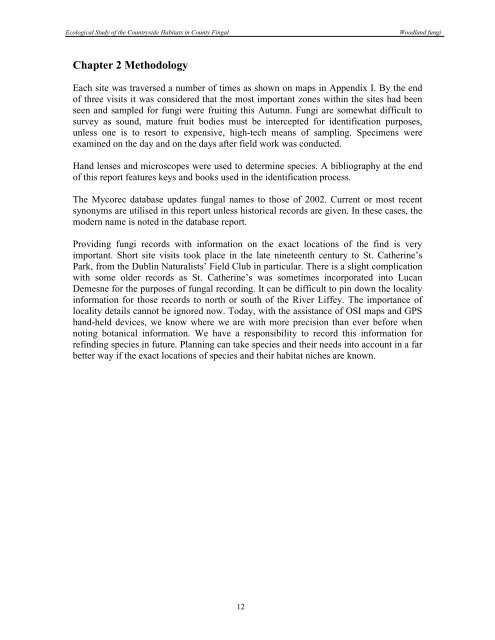2006 Fungi of Fingal Woodlands - Fingal Biodiversity
2006 Fungi of Fingal Woodlands - Fingal Biodiversity
2006 Fungi of Fingal Woodlands - Fingal Biodiversity
Create successful ePaper yourself
Turn your PDF publications into a flip-book with our unique Google optimized e-Paper software.
Ecological Study <strong>of</strong> the Countryside Habitats in County <strong>Fingal</strong> Woodland fungi<br />
Chapter 2 Methodology<br />
Each site was traversed a number <strong>of</strong> times as shown on maps in Appendix I. By the end<br />
<strong>of</strong> three visits it was considered that the most important zones within the sites had been<br />
seen and sampled for fungi were fruiting this Autumn. <strong>Fungi</strong> are somewhat difficult to<br />
survey as sound, mature fruit bodies must be intercepted for identification purposes,<br />
unless one is to resort to expensive, high-tech means <strong>of</strong> sampling. Specimens were<br />
examined on the day and on the days after field work was conducted.<br />
Hand lenses and microscopes were used to determine species. A bibliography at the end<br />
<strong>of</strong> this report features keys and books used in the identification process.<br />
The Mycorec database updates fungal names to those <strong>of</strong> 2002. Current or most recent<br />
synonyms are utilised in this report unless historical records are given. In these cases, the<br />
modern name is noted in the database report.<br />
Providing fungi records with information on the exact locations <strong>of</strong> the find is very<br />
important. Short site visits took place in the late nineteenth century to St. Catherine’s<br />
Park, from the Dublin Naturalists’ Field Club in particular. There is a slight complication<br />
with some older records as St. Catherine’s was sometimes incorporated into Lucan<br />
Demesne for the purposes <strong>of</strong> fungal recording. It can be difficult to pin down the locality<br />
information for those records to north or south <strong>of</strong> the River Liffey. The importance <strong>of</strong><br />
locality details cannot be ignored now. Today, with the assistance <strong>of</strong> OSI maps and GPS<br />
hand-held devices, we know where we are with more precision than ever before when<br />
noting botanical information. We have a responsibility to record this information for<br />
refinding species in future. Planning can take species and their needs into account in a far<br />
better way if the exact locations <strong>of</strong> species and their habitat niches are known.<br />
12


